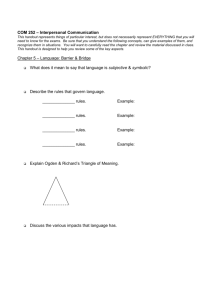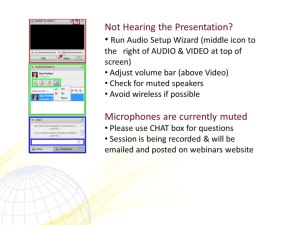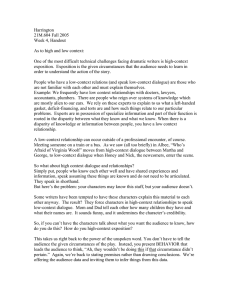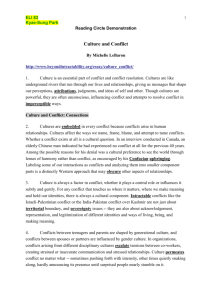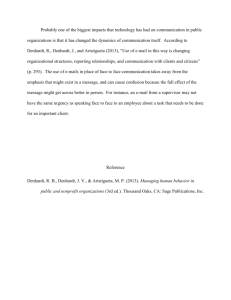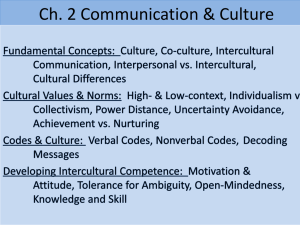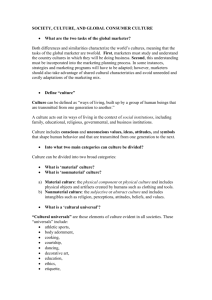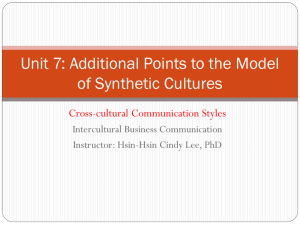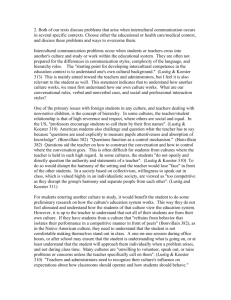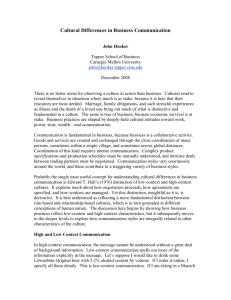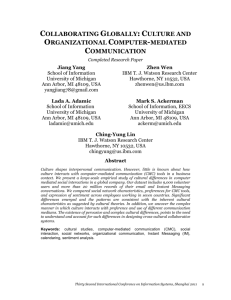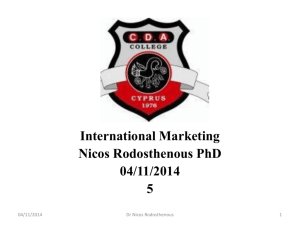Unit 3 - Communicating Culture
advertisement
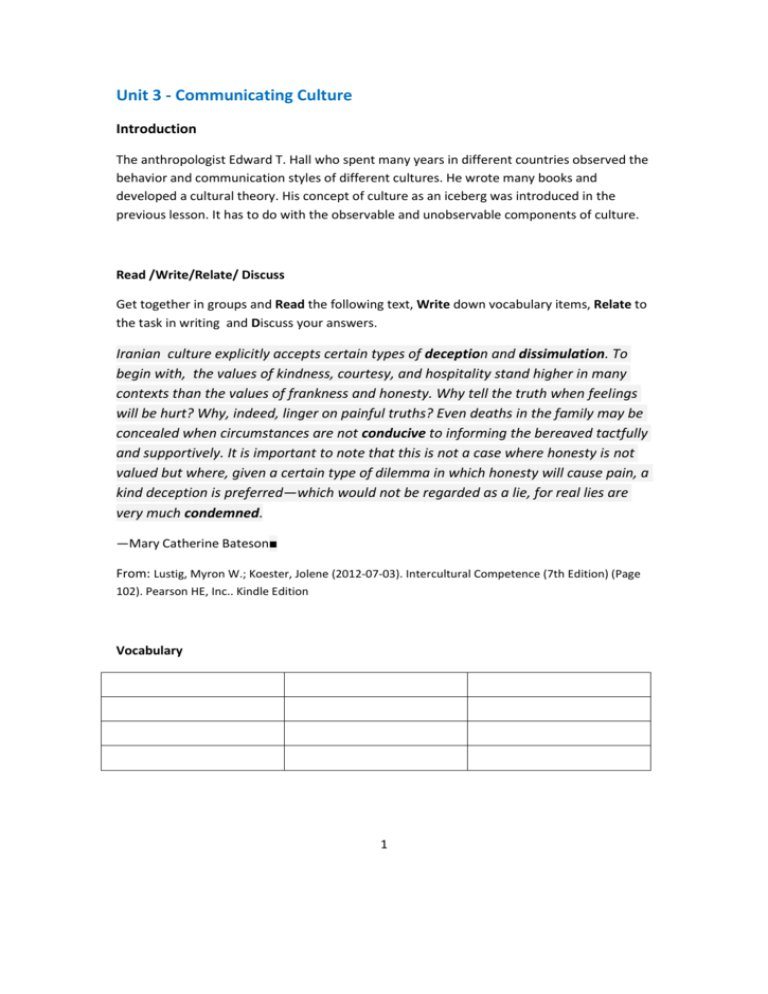
Unit 3 - Communicating Culture Introduction The anthropologist Edward T. Hall who spent many years in different countries observed the behavior and communication styles of different cultures. He wrote many books and developed a cultural theory. His concept of culture as an iceberg was introduced in the previous lesson. It has to do with the observable and unobservable components of culture. Read /Write/Relate/ Discuss Get together in groups and Read the following text, Write down vocabulary items, Relate to the task in writing and Discuss your answers. Iranian culture explicitly accepts certain types of deception and dissimulation. To begin with, the values of kindness, courtesy, and hospitality stand higher in many contexts than the values of frankness and honesty. Why tell the truth when feel ings will be hurt? Why, indeed, linger on painful truths? Even deaths in the family may be concealed when circumstances are not conducive to informing the bereaved tactfully and supportively. It is important to note that this is not a case where honesty is not valued but where, given a certain type of dilemma in which honesty will cause pain, a kind deception is preferred—which would not be regarded as a lie, for real lies are very much condemned. —Mary Catherine Bateson■ From: Lustig, Myron W.; Koester, Jolene (2012-07-03). Intercultural Competence (7th Edition) (Page 102). Pearson HE, Inc.. Kindle Edition Vocabulary 1 Task 1.Highlight and list all the values mentioned in the text in the order of importance to you. (Number 1 is the most important. Number 2 a little less and so on..) 2. What can be observed in the text with regards to components of culture? Refer to the Iceberg metaphor: a. What values/beliefs/norms are presented in this text. b. What kind of observable behavior is described here? ……………………………………………………………………………………………………………………………………………… ……………………………………………………………………………………………………………………………………………… ……………………………………………………………………………………………………………………………………………… ……………………………………………………………………………………………………………………………………………… ……………………………………………………………………………………………………………………………………………… ……………………………………………………………………………………………………………………………………………… ……………………………………………………………………………………………………………………………………………… ……………………………………………………………………………………………………………………………………………… ……………………………………………………………………………………………………………………………………………… ……………………………………………………………………………………………………………………………………………… Class work/Homework Google "Edward T. Hall" and write down 8-10 facts that are connected to his work on culture. 2 ……………………………………………………………………………………………………………………………………………… ……………………………………………………………………………………………………………………………………………… ……………………………………………………………………………………………………………………………………………… ……………………………………………………………………………………………………………………………………………… ……………………………………………………………………………………………………………………………………………… ……………………………………………………………………………………………………………………………………………… ……………………………………………………………………………………………………………………………………………… ……………………………………………………………………………………………………………………………………………… ……………………………………………………………………………………………………………………………………………… Lesson 3 - Part B We start this part by writing down the facts you found about Hall. Add more facts to your list (from information given by your classmates and/or teacher) ……………………………………………………………………………………………………………………………………………… ……………………………………………………………………………………………………………………………………………… ……………………………………………………………………………………………………………………………………………… ……………………………………………………………………………………………………………………………………………… (*note for the teacher - The term High/Low-Context cultures should be brought up.) So What is high-context and what is low-context culture ? Look at the following picture. Japanese tea ceremony is an 3 example of a high-context message. Nearly every movement, gesture, and action has significance to those who understand the “code” being used. Text from : Lustig, Myron W.; Koester, Jolene (2012-07-03). Intercultural Competence (7th Edition) (Page 102). Pearson HE, Inc.. Kindle Edition. Hall’s high- and low-Context Cultural Taxonomy Edward T. Hall organizes cultures by the amount of information implied by the setting or context of the communication itself, regardless of the specific words that are spoken. Hall places great importance on the role of context. According to Hall, cultures differ on a continuum that ranges from high to low context. High-context cultures prefer to use high context messages, in which most of the meaning is either implied by the physical setting or is presumed to be part of the individual's internalized beliefs, values, norms and social practices; very little is provided in the coded, explicit, transmitted part of the message. Examples of high-context cultures include Japanese, African American, Mexican, and Latino. Low-context cultures prefer to use low-context messages, in which the majority of the information is in the explicit voice code. Low-Context cultures include German, Swedish, European, American and English. Hall’s description of high- and low-context cultures is based on the idea that some cultures have a multitude of messages that are high context, others have messages that are mostly low context and yet others have a mixture of both. Hall also describes other characteristics 4 of high and low- context cultures that reveal the beliefs, values, norms and social practices of the cultural system. These characteristics include the use of covert and overt messages, the importance of in-groups and outgroups and the culture's orientation of time. Vocabulary More Explanations on High-context and Low-context cultures- Let's discuss them 5 Let's have another Socratic seminar. You receive the text (the following story) and time you need to prepare. First make sure you understand the words. Then you need to jot ideas, highlight part of the text that you feel are important in terms of culture and should be discussed. 6 A young couple met, fell in love, and wanted to marry. She was from a wealthy and well-connected family, whereas he was from a family of more modest means, but the young couple did not regard this difference as a problem. So they shared their happy news with their respective families; shortly thereafter, the young man’s parents were invited to the woman's home to socialize and to meet her parents. The social occasion was very cordial; the conversation was pleasant , and the two sets of parents were very gracious toward one another. At the appropriate time, the woman's parents served nasi goring (fried rice) and star fruit, two foods that are very common in Indonesia. Finally, after an appropriate interval, the young man's parents thanked their hosts and left. Throughout the entire episode, the topic of the wedding was never introduced. However, everyone knew that the wedding would never occur. After all, nasi goring doesn't go with star fruit; the high-context and face-saving message that the woman's parents communicated, and that the man's parents clearly understood, was that they disapproved of the marriage . From: : Lustig, Myron W.; Koester, Jolene (2012-07-03). Intercultural Competence (7th Edition) (Page 102). Pearson HE, Inc.. Kindle Edition. Vocabulary 7 Ideas and things you would like to discuss: ……………………………………………………………………………………………………………………………………………… ……………………………………………………………………………………………………………………………………………… ……………………………………………………………………………………………………………………………………………… ……………………………………………………………………………………………………………………………………………… ……………………………………………………………………………………………………………………………………………… ……………………………………………………………………………………………………………………………………………… ……………………………………………………………………………………………………………………………………………… ……………………………………………………………………………………………………………………………………………… ……………………………………………………………………………………………………………………………………………… ……………………………………………………………………………………………………………………………………………… Homework: How would you describe your culture? High or Low-Context/a mixture of both ? Support your answer with characteristics from Hall's theory and give examples from life and reality in Israel. Relate to at least four characteristics and provide examples for each. ……………………………………………………………………………………………………………………………………………… ……………………………………………………………………………………………………………………………………………… ……………………………………………………………………………………………………………………………………………… ……………………………………………………………………………………………………………………………………………… ……………………………………………………………………………………………………………………………………………… ……………………………………………………………………………………………………………………………………………… ……………………………………………………………………………………………………………………………………………… ……………………………………………………………………………………………………………………………………………… 8 ……………………………………………………………………………………………………………………………………………… ……………………………………………………………………………………………………………………………………………… ……………………………………………………………………………………………………………………………………………… 9
